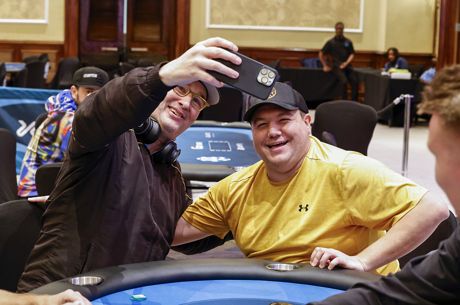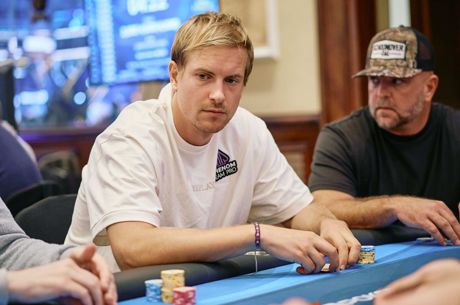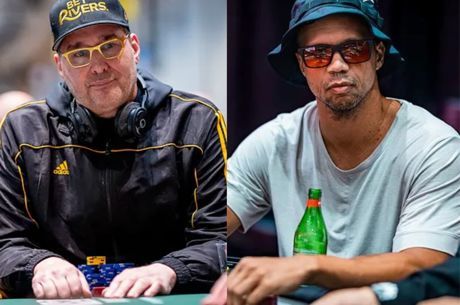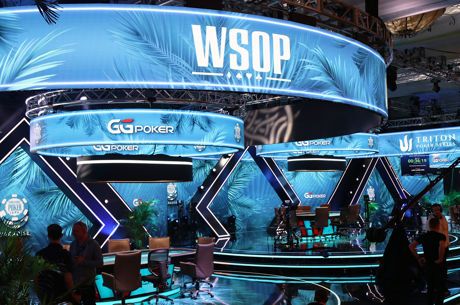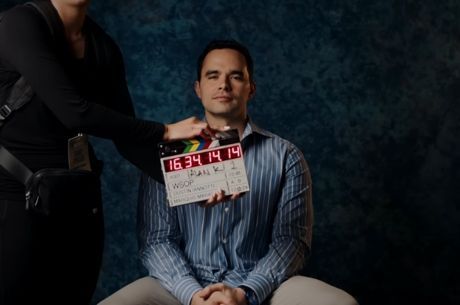The Story on How the 2004 World Series of Poker Was Almost Cancelled

Writer’s Note: Ten years ago, the World Series of Poker was held for the last time in its entirety at Binion’s Horseshoe. What few people know is the WSOP almost didn’t happen that year. A few months after Chris Moneymaker’s victory ignited the poker boom, the casino was boarded up, padlocked by federal marshals, and eventually sold off to Harrah’s Entertainment. The shuttered building sat dark and vacant during the entire winter of 2004. Yet somehow by April 23, the casino was re-opened for business again and was ready to host the 35th annual WSOP. This is the story of how that remarkable poker series came to be, against all odds.
Binion’s Horseshoe was a total fuckhouse.
Sure, it was a great place to work when I was there. And I wouldn’t trade those memories for the world. But not everyone saw it that way.
By the time the doors were nailed shut and boarded over with plywood in January of 2004, more than 800 former employees were flushed out into the streets looking for work. That might not seem like a big deal. People lose jobs all the time. But the vast majority of former Horseshoe workers had been around for years, like barnacles attached to a sunken ship. They weren’t just part of the local scene — they were the scene. They’d given their lives to the Binion family and that grand old building so embarrassingly out-of-touch with the times. Now, here they were — mostly older people with retirement plans now stripped away — having to hustle to find a job.
Being somewhere over the rainbow in years made things difficult enough. But then there was the additional baggage we each carried. One by one, we gradually came to realize how deep-rooted our outlaw reputations were within the casino industry. We weren’t black sheep. We were child molesters. No one wanted anything to do with us.
Being a former Horseshoe employee was like wearing The Scarlet Letter. Most of the former employees I kept in touch with had serious difficulty finding work. After so much rejection, the explanation became painfully obvious. Why else were so many good people with multiple years of casino experience not getting hired anywhere else — especially on The Las Vegas Strip, which at the time was going through a boom period?
As phone calls went unreturned and rejection letters piled up, rather than tout one’s experience as a laid-off Horseshoe employee, some of my former associates began doing what was unthinkable. They left blank spaces on their résumés. If some nosy interviewer in personnel somewhere got curious and asked where they’d been working the past three years, the applicant might as well respond with "serving time." It was pretty much the same thing. Being associated with the Horseshoe was like getting out of a prison and looking for work while out on parole.
I was far luckier than most.
In fact, I was probably the luckiest former Horseshoe employee of all.
Call it the winter of WSOP discontent. Downtown Las Vegas was already dying. And the downward spiral seemed irreversible.
This was long before any new high-rise condos had yet been built. Before the world-class symphony hall called The Smith Center opened. Before Fremont Street expanded. Before any major renovations to the casinos were done. Before the exciting youth-oriented culture of Zappo’s moved in. Downtown was a crime-ridden zone of low-end tourists and bad smells on its way to becoming a ghost town.
When Harrah’s Entertainment announced they’d taken over the property, the news came as a huge relief to just about everyone — most of all Las Vegas Mayor Oscar Goodman.
The former mayor (and mob lawyer before that) was Downtown Las Vegas’ greatest champion and biggest cheerleader. Mayor Goodman rightfully deserves lots of credit for being the first visionary to make the dream possible. He helped organize a total renovation of the blighted urban zone that had once been the core center of the gambling universe. Now in the midst of his second term in office, the Horseshoe Casino, one of the most recognizable institutions of Fremont Street, sat dark and empty. He and everyone else involved in the new downtown project realized that investment would be hard to come by as long as one of the most famous street blocks in the country looked like a deserted old tenement.
When Harrah’s (now Caesars Entertainment) rode in with a white horse of new investment and enthusiasm, they seemed the perfect suitor. First, Harrah’s was in a major acquisition mode at the time. They were snatching up anything and everything gaming-related, well on their way to becoming the world’s largest casino company. Second, they had plenty of money to spend and resources to commit in order to refurbish the property. Third, Harrah’s had a reputation as a stable company that didn’t get in over its head. Harrah’s properties largely catered to middle-class gamblers, apparently very good news for the World Series of Poker, which is the ultimate "everyman" pursuit.
Not everything that was reported at the time was accurate. There were erroneous reports stating that one of the main reasons that Harrah’s wanted to buy Binion’s Horseshoe was to acquire rights to the tournament. That simply is not true. According to my sources at the time, the WSOP was an afterthought. For Harrah’s, it was like buying a building and then finding out it comes with an attached garage. The WSOP was the garage. It had little or nothing to do with Harrah’s making the deal.
Of course, no one could have foreseen what was to come. No one knew nor understood the real value of the annual tournament, and the potential upside. No one could possibly have predicted how the tournament series would soon be worth far more than the building which still stands and now goes simply by the name "Binion’s" — even though it’s no longer owned by Harrah’s/Caesars, nor has anything at all to do with the Binion family.
From its outward appearance, Binion’s Horseshoe may still be standing. But the spirit is long gone. It departed long ago.
The phone rang in Howard Greenbaum’s office.
Greenbaum is a longtime Harrah’s Entertainment executive, who knows just about every facet of the casino business. He operates with what I’d call a consistent exactitude. Greenbaum was the first Harrah’s employee on the scene and remains very much involved in the WSOP to this day.
On the other end of the line was Tom Jenkin, another Harrah’s executive with deep roots. Jenkin was a remarkable success story. He started out in the casino business working as a busboy in one of the kitchens. Jenkin busted his ass for years and slowly climbed all the way up the corporate ladder to become the head of nearly a dozen casinos scattered throughout the Western United States.
Greenbaum and Jenkin, both self-made men who were book wise and street smart, talked on the phone as old friends — as indeed they’d been for many years.
Jenkin told Greenbaum to head downtown to the Horseshoe, which was now under the lock and key possession of Harrah’s Entertainment. Greenbaum was instructed to make a personal on-site inspection. He was to determine if the dilapidated old relic was suitable for re-opening anytime soon. Moreover, Jenkin wanted to know if the property could possibly be up and running in time to host what was expected to be a record turnout of poker players, now just a couple of months away.
Even asking the question about whipping the Horseshoe into shape seemed absurd.
Harrah’s set its priorities, turning the 2004 WSOP not only into a reality, but a major success story. The work behind the scenes merits a standing ovation, and then some. It’s almost impossible to imagine how bad a shape the Horseshoe was in at the time. Planning the WSOP under normal conditions would be tough enough within such a short time span with new management, which had never run an event of that size before. Add a crumbling building on its last legs, and the challenges were compounded beyond what seemed doable.
That winter, as directed, Greenbaum drove down to the Horseshoe to do an inspection. Admittedly, this was a place he hadn’t visited in years. He had no idea what to expect when he stepped inside.
Whatever nightmare scenario Greenbaum imagined when he entered that musty old building actually turned out to be worse. No one could have blamed Greenbaum and Harrah’s Entertainment had they simply announced the WSOP would be forced to skip a year, or be postponed indefinitely. After all, none of the parts were in place to host a successful tournament. It would take several months, perhaps longer, to do it right. And Harrah’s could have embarrassed themselves badly by rushing things and trying to do what seemed impossible.
Cancelling the 2004 WSOP was probably the wise decision. But that’s not the way Greenbaum and Jenkin saw things. They were up for challenges.
With Greenbaum’s new leadership of the WSOP, combined with another casino executive named Wade Faul — who soon became the new General Manager — the Horseshoe had two key players in place to turn the 2004 WSOP into a reality.
Now, all they had to do was perform some magic. That meant transforming a building one step away from demolition into an operating casino. That also meant hiring the right people to do much of the work.
The 2004 WSOP was just six weeks away.
What I remember was the filth. The dust. The grime. The stench.
Desecration piled high. Neglect buried deep. Everything covered in a volcanic-like ash. Rotting food encased inside unplugged refrigerators. Electrical wires hanging down from the ceiling. Gambling devices littering the casino floor.
Binion’s Horseshoe had become a dead zone.
The Horseshoe had been closed for months. Stepping inside again for the first time since I’d been fired by the previous owner Becky Binion-Behnen was like cracking open a tomb. One was fearful of peeking inside. What became of this graveyard of utter stillness, this final resting place of silent skeletons keeping all the tales buried forever that we shall never know?
My initial thought was — the building didn’t need a makeover. It needed a wrecking ball.
Yet, the Horseshoe was a place of wonderful memories, where our collective histories — poker history, gambling history, and Las Vegas history — had not only been bronzed, but canonized as folklore.
Some of the old guard was brought back — including myself. Matt Savage was re-hired to be the WSOP Tournament Director again, for the third straight year. Savage brought along his best people as floor staff. Mike O’Malley was hired to be the head of administration. Meg Patrick was the Dealer Coordinator, probably the most thankless job on the entire staff. Harrah’s was even determined to re-open the poker room, and brought in Michael Soto to run things. As for poker dealers, getting the most essential employees of all back on the payroll with the old management-dealer squabbles now behind us, would certainly make things easier.
Harrah’s also used the services of a public relations agency, something I wasn’t used to. The agency people based out of Baltimore came into town to scope out the landscape. Initially, I didn’t care much for these outsiders being brought in, who seemed intent on making all the decisions even though none of them knew shit about poker. The leader of the insurrection was named Dave Curley, who as it turned out would be around the WSOP for the next several years. Curley and I had several knock-down drag-out fights over the years, but eventually became the best of friends, and remain so. Funny how that works sometimes. I like to think Curley just eventually came to see the world my way, which is now why we get along so well.
Fittingly, we held our first meeting inside the vacant Horseshoe around an abandoned poker table. Like a conquering army showing off the spoils of war, there was an odd feeling about having so many new people on the scene now, running things and making decisions. While junk was being wheeled out the side doors and new equipment was brought in, the atmosphere of the first few meetings seemed like a construction site. That’s the way the Horseshoe was for the next month, as opening day of the WSOP approached.
Somehow, it all came together. Sure, there were some problems. But each day the building looked a little bit more like a real casino. Each day a section was cleaned. Each day, fresh wires were installed. Each day, new tables were brought in. Each day, a few more people were added to the staff. Each day, we got closer and closer to the grand re-opening. Each day brought us closer to the 2004 WSOP, which was now going to happen, no matter what.
The word "miracle" is overused, but the fact that the 2004 WSOP happened at all was a miracle.
That year, the WSOP lasted 31 days, making it the longest tournament series in history.
Virtually every gold bracelet event set a new record for attendance and prize money. The Main Event, which the year before had been the biggest ever, tripled in size.
By the time Greg “Fossilman” Raymer was crowned the new world champion of poker, it became obvious to everyone that the WSOP had outgrown its childhood home. An event of such enormous size and magnitude needed someplace that was substantially newer and bigger. The old Horseshoe couldn’t keep up with the times.
Although great memories would be left behind, a new era was about to begin.
About the Author: Nolan Dalla has been involved in poker as a full-time and part-time player, writer/reporter, author, consultant, and casino executive for more than 20 years. He's best known as the longtime Media Director of the World Series of Poker. Dalla is also actively involved in a new television show coming soon called “Poker Night in America.” He writes a popular daily blog on a variety of current events. It can be read at his website: www.NolanDalla.com.
This article was originally published on NolanDalla.com.
Photo courtesy of Paul Mannix.
Get all the latest PokerNews updates on your social media outlets. Follow us on Twitter and find us both Facebook and Google+!





